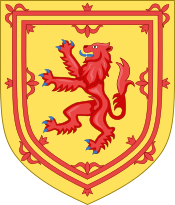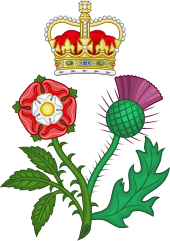Jacobitism
Jacobitism (/ˈdʒækəbaɪˌtɪzəm/ JAK-ə-bye-tiz-əm; Scottish Gaelic: Seumasachas, [ˈʃeːməs̪əxəs̪]; Irish: Seacaibíteachas, Séamusachas) was a largely 17th- and 18th-century movement that supported the restoration of the House of Stuart to the British throne. The name is derived from Jacobus, the Latin version of James.
| Jacobitism | |
|---|---|
| |
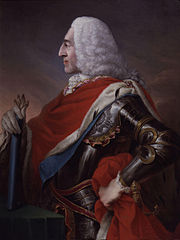 James Francis Edward Stuart, Jacobite claimant between 1701 and 1766 | |
| Active | 1688–1780s |
| Ideology |
|
| Leaders |
|
| Military leaders |
|
| Area of operations | Kingdom of Great Britain and Kingdom of Ireland |
| Allies |
|
| Opponent(s) |
|
When James II and VII went into exile after the 1688 Glorious Revolution, the Parliament of England argued he abandoned the English throne and offered it to his Protestant daughter Mary II and her husband William III.[1] In April, the Scottish Convention held he "forfeited" the throne of Scotland by his actions, listed in the Articles of Grievances.[2]
The Revolution created the principle of a contract between monarch and people; if that was violated, he or she could be removed. Jacobites argued monarchs were appointed by God, or divine right, and could not be removed, making the post-1688 regime illegitimate. While this was the most consistent difference, Jacobitism was a complex mix of ideas, many opposed by the Stuarts themselves; in Ireland, it meant tolerance for Catholicism, which James supported, but also Irish autonomy and reversing the 17th-century land settlements, which he opposed. In 1745, the opposition of Scots Jacobites to the 1707 Union and divine right was central to the internal conflicts that ended it as a viable movement.
Outside Ireland, Jacobitism was strongest in the western Scottish Highlands, Perthshire and Aberdeenshire, and areas of Northern England with a high proportion of Catholics such as western Lancashire, Northumberland and County Durham.[3] Sympathisers were also found in parts of Wales, and in the West Midlands and South West England, to some degree overlapping with the Royalist strongholds of the Civil War era. The movement had an international dimension; several European powers sponsored the Jacobites as an extension of larger conflicts, while many Jacobite exiles served in foreign armies.
In addition to the 1689–1691 Williamite War in Ireland and the simultaneous conflict in Scotland, there were open Jacobite revolts in Scotland and England in 1715, 1719 and 1745–6; abortive French-backed invasion attempts in 1708 and 1744; and several unsuccessful plots. While the 1745 rising was briefly a serious crisis for the British state, leading to the recall of British troops from Continental Europe, its collapse and the 1748 withdrawal of French support ended Jacobitism as a serious political movement.
Political background
| Part of the Politics series on |
| Toryism |
|---|
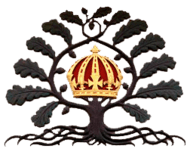 |
|
Characteristics
|
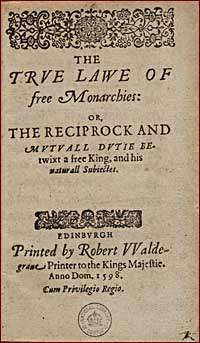
Jacobite ideology originated with James VI and I, first monarch of England, Scotland and Ireland in 1603. Its basis was divine right, which claimed his position and authority came from God, and the duty of subjects was to obey. Personal rule eliminated the need for Parliaments, and required political and religious union of all three kingdoms.[4] Catholic allegiance to the Pope and Protestant nonconformists belief were incompatible with divine right, since both argued there was an authority above the king.[5]
In the 17th century, links between religion and political beliefs meant disputes in one area fed into the other, particularly as government was often seen as a microcosm of a larger, divine order. The spread of Millenarianism and belief in the imminence of the Second Coming meant many Protestants in particular viewed such issues as urgent and real.[6]
As the first step towards a single kingdom, James began creating standard practices between the churches of England, Scotland and Ireland. This continued after 1625 under Charles I, but enforcing Laudian practices on the Church of England, and ruling without Parliament led to a political crisis.[7] Similar measures in Scotland caused the 1639-1640 Bishops' Wars, and installation of a Covenanter government.[8]
Organised by a small group of Catholic nobility, the October 1641 Irish Rebellion was the cumulative effect of land confiscation, loss of political control, anti-Catholic measures and economic decline. Intended as a bloodless coup, its leaders quickly lost control, leading to atrocities on both sides.[9] In May, a Covenanter army landed in Ulster to support Scots settlers; the English Parliament refused to fund an army, fearing Charles would use it against them, and the First English Civil War began in August.[10]
_with_M._de_St_Antoine_-_Google_Art_Project.jpg)
In 1642, the Catholic Confederacy representing the Irish insurgents proclaimed allegiance to Charles, but the Stuarts were an unreliable ally, since concessions in Ireland cost them Protestant support in all three kingdoms. In addition, the Adventurers' Act, approved by Charles in March 1642, funded suppression of the revolt by confiscating land from Irish Catholics, much of it owned by members of the Confederacy.[11]
The result was a three-way contest among the Confederacy, Royalist forces under the Protestant Duke of Ormond, and a Covenanter-led army in Ulster. The latter were increasingly at odds with the English government; after Charles' execution in January 1649, Ormond combined these factions to resist the 1649 to 1652 Cromwellian conquest of Ireland.[12]
Charles II repudiated his alliance with the Confederacy, in return for Scottish support in the Third English Civil War, and Ormond went into exile in 1650. Defeat in 1652 led to the mass confiscation of Catholic and Royalist land, and its re-distribution among English Parliamentary soldiers and Protestant settlers.[13] The three kingdoms were combined into the Commonwealth of England, regaining their separate status when the monarchy was restored in 1660.[14]
Charles's reign was dominated by the expansionist policies of Louis XIV of France, seen as a threat to Protestant Europe. When his brother and heir James announced his conversion to Catholicism in 1677, an attempt was made to bar him from the English throne.[15] Nevertheless, he became king in February 1685 with widespread support in England and Scotland; a Catholic monarch was preferable to excluding the 'natural heir', and rebellions by Protestant dissidents quickly suppressed. It was also viewed as temporary; James was 52, his second marriage was childless after 11 years, and his Protestant daughter Mary was heir.[16]
His religion made James popular among Irish Catholics, whose position had not improved under his brother. By 1685, Catholic land ownership had fallen to 22%, versus 90% in 1600, and after 1673, a series of proclamations deprived them of the right to bear arms or hold public office.[17] The Catholic Richard Talbot, 1st Earl of Tyrconnell was appointed Lord Deputy of Ireland in 1687, and began building a Catholic establishment that could survive James. Fearing a short reign, Tyrconnell moved at a speed that destabilised all three kingdoms.[18]
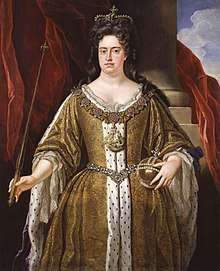
James dismissed the English and Scottish Parliaments when they refused to approve his measures of religious tolerance, which he enforced using the Royal Prerogative. Doing so threatened to re-open disputes over religion, reward those who rebelled in 1685 and undermine his own supporters. It also ignored the impact of the 1685 Edict of Fontainebleau, which revoked tolerance for French Protestants and created an estimated 400,000 refugees, 40,000 of whom settled in London.[19]
Two events in June 1688 turned discontent into rebellion; first, the birth of James's son, creating the prospect of a Catholic dynasty. Second, prosecution of the Seven Bishops, which seemed to signal an assault on the established churches; their acquittal caused widespread rejoicing throughout England and Scotland, and destroyed James's political authority.[20]
In 1685, many had feared civil war if James were bypassed; by 1688, even the Earl of Sunderland, his chief minister, felt only his removal could prevent it. Sunderland secretly co-ordinated an Invitation to William, assuring Mary and her husband William of Orange of English support for armed intervention. William landed in Brixham on 5 November with 14,000 men; as he advanced, James's army deserted and he went into exile on 23 December.[21] In February 1689, William and Mary were appointed joint monarchs of England, followed by Scotland in March.[22]
Most of Ireland was still controlled by Tyrconnell and on 12 March 1689, James landed with 6,000 French troops. The 1689 to 1691 War in Ireland highlighted two recurring trends; James and his successors viewed Ireland and Scotland as secondary to the main prize of England, while French backing was intended to support the wider Nine Years' War, not necessarily to restore the Stuarts.[23] Elections in May 1689 produced the first Irish Parliament with a Catholic majority since 1613. It repealed the Cromwellian land seizures, confiscated land from Williamites, and proclaimed Ireland a 'distinct kingdom from England', measures annulled after defeat in 1691.[24]
A minor Jacobite rising in Scotland was suppressed. The Irish Jacobites were defeated at Boyne in July 1690, but victory several days later at Beachy Head gave the French temporary control of the Channel. James returned to France to urge an immediate invasion of England, but the Anglo-Dutch fleet soon regained maritime supremacy, and the opportunity was lost.[25]
The 1691 Treaty of Limerick ended the war in Ireland; future risings on behalf of the exiled Stuarts were confined to England and Scotland. The 1701 Act of Settlement barred Catholics from the English throne, and when Anne became the last Stuart monarch in 1702, her heir was her Protestant cousin Sophia of Hanover, not her Catholic half-brother James. Ireland retained a separate Parliament until 1800, but the 1707 Union combined England and Scotland into the Kingdom of Great Britain. Anne viewed this as the unified Protestant kingdom which her predecessors had failed to achieve.[26]
However, the ousted Stuart dynasty, backed by European Catholic powers such as France and Spain, continued to plot a return to power in the three kingdoms of England, Scotland and Ireland, by force in necessary, and retained supporters in each of those kingdoms.
Jacobite supporters in the three kingdoms
Jacobite support in the three kingdoms of England, Scotland and Ireland was rooted partly in specific religious communities and among those whose political beliefs encompassed the core Stuart doctrines of divine right, sacred kingship and indefeasible hereditary right. However, the motivation of individual Jacobites varied widely across the Stuarts' former realms: establishing motivation is complicated by the fact that "by and large, those who wrote most did not act, and those who acted wrote little, if anything".[27] Historians have characterised the movement in a variety of ways, including as a revolutionary extension of anti-Court, 'Country' ideology; an aristocratic reaction against a growth in executive power; a simple conflict between feudalism and capitalism; or as a product of nationalist feeling in Scotland and Ireland.[28]
Ireland
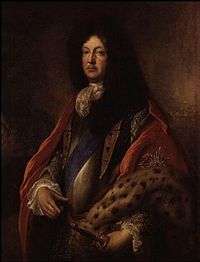
The role of Jacobitism in Irish political history is debated; some argue it was a broad based popular movement, and the main driver of Irish Catholic nationalism between 1688 and 1795.[29] Others see it as part of "a pan-British movement, rooted in confessional and dynastic loyalties", very different from 19th century Irish nationalism.[30]
Historian Vincent Morely describes Irish Jacobitism as a distinctive ideology within the broader movement, that "emphasised the Milesian ancestry of the Stuarts, their loyalty to Catholicism, and Ireland's status as a kingdom with a Crown of its own.'[31] In the first half of the 18th century, Jacobitism was "the primary allegiance of politically conscious Catholics".[32]
Irish Catholic support for James was based primarily on his religion and willingness to deliver their demands. In 1685, Gaelic poet Dáibhí Ó Bruadair celebrated his accession as ensuring the supremacy of Catholicism and the Irish language. Tyrconnell's expansion of the army by the creation of Catholic regiments was welcomed by Diarmuid Mac Carthaigh, as enabling the native Irish 'Tadhg' to be armed and to assert their dominance over 'John' the English Protestant.[33]
Conversely, most Irish Protestants viewed his policies as designed to "utterly ruin the Protestant interest and the English interest in Ireland".[34] This restricted Protestant Jacobitism to "doctrinaire clergymen, disgruntled Tory landowners and Catholic converts", who opposed Catholicism but still viewed James' removal as unlawful.[35] A few Church of Ireland ministers refused to swear allegiance to the new regime and became Non-Jurors, the most famous being propagandist Charles Leslie.[36]
In May 1689, James called an Irish Parliament in Dublin to fund his war effort, the first since 1666. Tyrconnell ensured a predominantly Catholic electorate and candidates by issuing new borough charters, admitting Catholics into city corporations, and removing "disloyal members".[37] Since elections were not held in many northern areas, the House of Commons was 70 members short, and 224 out of 230 MPs were Catholic.
Its key demands mirrored those made by the Confederacy in 1642. The Parliament opened by acclaiming James as the rightful king and condemnation of his "treasonous subjects" who had ousted him.[38] There was some division between the majority in parliament, who voted for a complete restoration of lands held by Catholics prior to the Cromwellian Conquest and Tyrconnell and some of the House of Lords, who proposed that they would receive back only half of their old estates.[39] However, as the House of Commons was overwhelmingly in favour of complete restoration of confiscated lands, Tyrconnell assented and persuaded the House of Lords to vote through the bill.[40]
More serious were the differences between the Irish parliament and James himself. James, whose priority was recovering the throne of England, complained that "he was fallen into the hands of a people who would ram many hard things down his throat" [41] and attempted to resist measures that might "dissatisfy his Protestant subjects". However the parliament made it clear that it would not vote him taxation if he did not accede to their minimum demands.[42] James reluctantly approved the restoration of pre-1650s Catholic landowners to their estates and an Act of Attainder, which confiscated the estates of 2,000 mostly Protestant "rebels". With equal reluctance he assented to the parliament's assertion that Ireland was a "distinct kingdom" and that laws passed by English Parliament did not apply there. However, he refused to agree to the abolition of Poynings' Law, which required Irish legislation to be approved by the English Parliament.[43] The Protestant Church of Ireland retained its legal pre-eminence, although it was agreed that landowners would only have to pay tithes to clergy of their own religion.[42]
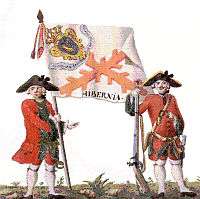
James left Ireland after defeat at the Boyne in 1690, telling his supporters to "shift for themselves". [44] This led some to depict him as "Seamus an chaca", or "James the shit", who had deserted his loyal followers.[45] However, Gaelic scholar Breandán Ó Buachalla claims his reputation subsequently recovered as "the rightful king...destined to return' and upper-class Irish Jacobite writers like Charles O'Kelly and Nicholas Plunkett blamed "corrupt English and Scottish advisors" for his apparent desertion.[46]
After 1691, measures passed by the 1689 Parliament were annulled, penal laws barred Catholics from public life and land confiscations resumed. 12,000 Jacobite soldiers went into exile in the diaspora known as the Flight of the Wild Geese, the majority of whom were later absorbed into the French Irish Brigade. About 1,000 men were recruited for the French and Spanish armies annually, many with a "tangible commitment to the Stuart cause".[47] Elements of the French Irish Brigade participated in the Scottish Jacobite rising of 1745.[48]
Irish language poets, especially in Munster, continued to champion the cause after James' death; in 1715, Eoin O Callanain described his son James Francis Edward Stuart as "taoiseach na nGaoidheal" or "chieftain of the Gaels".[49] As in England, throughout the 1720s, James' birthday on 10 June was marked by celebrations in Dublin, and towns like Kilkenny and Galway. These were often accompanied by rioting, suggested as proof of popular pro-Jacobite sympathies.[50] Others argue riots were common in 18th century urban areas and see them as a "series of ritualised clashes".[51]
Combined with Jacobite rhetoric and symbolism among rapparees or bandits, some historians claim this provides evidence of continuing popular support for a Stuart restoration.[52] Other however argue that it is hard to descern "how far rhetorical Jacobitism reflected support for the Stuarts, as opposed to discontent with the status quo".[53] Nevertheless, fears of resurgent Catholic Jacobitism among the ruling Protestant minority meant anti-Catholic Penal Laws remained in place for most of the eighteenth century.[54]
There was no Irish rising in either 1715 or 1745 to accompany those in England and Scotland; one suggestion is after 1691, for various reasons Irish Jacobites looked to European allies, rather than relying on a domestic revolt.[45] From the 1720s on, many Catholics were willing to swear loyalty to the Hanoverian regime, but not the Oath of Abjuration, which required renouncing the authority of the Pope, as well as the Stuarts.[55]
After the effective demise of the Jacobite cause in the 1750s, many Catholic gentry withdrew support from the Stuarts. Instead, they created organisations like the Catholic Convention, which worked within the existing state for redress of Catholic grievances.[56] When Charles died in 1788, Irish nationalists looked for alternative liberators, among them the French First Republic, Napoleon Bonaparte and Daniel O'Connell.[57]
England and Wales
.jpg)
In England and Wales, Jacobitism was often associated with the Tories, many of whom supported James's right to the throne during the Exclusion Crisis. Tory ideology implied that neither "time nor statute law [...] could ameliorate the sin of usurpation",[58] while shared Tory and Jacobite themes of divine right and sacred kingship may have provided an alternative to Whig concepts of "liberty and property".[59] A minority of academics, including Eveline Cruickshanks, have argued that until the late 1750s, the Tories were a crypto-Jacobite party, others that Jacobitism was a "limb of Toryism".[60]
However, the supremacy of the Church of England was also central to Tory ideology: when this had seemed threatened by James's policies, they became closely involved in his removal. The 1701 Act of Settlement excluding Catholics from the English throne was passed by a Tory administration; for the vast majority, Stuart Catholicism was an insuperable barrier to active support, while the Tory doctrine of non-resistance also discouraged them from supporting the exiles against a reigning monarch.[61]
For most of the period from 1690 to 1714, Parliament was either controlled by the Tories, or evenly split with the Whigs; when George I succeeded Anne, most hoped to reconcile with the new regime. The Earl of Mar, who led the 1715 rising, observed "Jacobitisme, which they used to brand the Tories with, is now I presum out of doors".[62] However, George blamed the 1710 to 1714 Tory government for the Peace of Utrecht, which he viewed as damaging to Hanover. His isolation of former Tory ministers like Lord Bolingbroke and the Earl of Mar drove them first into opposition, then exile. Exclusion from power between 1714 and 1742 meant many Tories sought opportunities to change the existing government, including contact with the Jacobite court.[63]
In 1715, there were co-ordinated celebrations on 29 May, Restoration Day, and 10 June, James Stuart's birthday, especially in Tory-dominated towns like Bristol, Oxford, Manchester and Norwich, although they remained quiet in the 1715 Rising. In the 1730s, many 'Jacobite' demonstrations in Wales and elsewhere were driven by local tensions, especially hostility to Methodism, and featured attacks on Nonconformist chapels.[64]
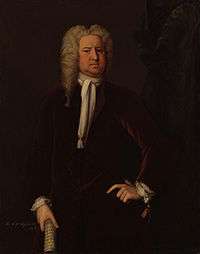
Most English participants in 1715 came from traditionally Catholic areas in the Northwest, like Lancashire.[65] By 1720, they numbered under 115,000 in England and Wales, and most remained loyal in 1745, including the Duke of Norfolk, head of the English Catholic community, sentenced to death for his role in 1715 but pardoned.[66] Even so, sympathies were complex; Norfolk's agent Andrew Blood joined the Manchester Regiment, and he later employed another ex-officer, John Sanderson, as his master of horse.[67] English Catholics provided the exiles with financial support into the 1770s.[68]
In 1689, around 2% of clergy in the Church of England refused to take the oath of allegiance to William and Mary; one list identifies a total of 584 clergy, schoolmasters and university dons as Non Jurors. [69] This almost certainly understates their numbers, since many sympathisers remained within the Church of England, but Non Jurors were disproportionately represented in Jacobite risings and riots, and provided many "martyrs". By the late 1720s, arguments over doctrine and the death of its originators reduced the church to a handful, but several of those executed in 1745 came from Manchester, the last significant congregation in England.[70]
The Quaker leader, William Penn was a prominent non-conformist supporter of James, although this was based on their personal relationship and did not survive his deposition. Another element in English Jacobitism was a handful of disaffected radicals, for whom the exiled Stuarts provided a potential alternative to the Whig establishment. An example was John Matthews, a Jacobite printer executed in 1719; his pamphlet Vox Populi vox Dei emphasised the Lockean theory of the social contract, a doctrine very few Tories of the period would have supported.[71]
Scotland
.jpg)
Scottish Jacobitism had wider and more extensive roots than in England. 20,000 Scots fought for the Jacobites in 1715, compared to 11,000 who joined the government army, and were the majority of the 9,000 to 14,000 who served in 1745.[72]
One reason was the feudal nature of land tenure in parts of rural Scotland, where tenants could be compelled to provide their landlords with military service. Many of the Highland clansmen who were a feature of Jacobite armies were raised this way: in all three major risings, the bulk of the Highland contingent came from a small number of north-western clans whose leaders joined the rebellion.[73]
Despite this, rather than the Catholic, Gaelic-speaking Highlanders of legend, many Jacobites were from the Lowlands, and most were Protestant.[74] By 1745, fewer than 1% of Scots were Catholic, restricted to the far north-west and a few noble families.[75] The majority of the rank and file, as well as many Jacobite leaders, belonged to Protestant Episcopalian congregations.[76]
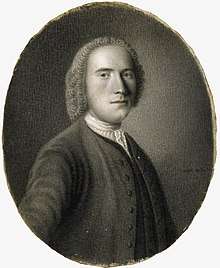
Throughout the 17th century, the close connection between Scottish politics and religion meant changes of regime were accompanied by the losers being expelled from the kirk. In 1690, over 200 clergy lost their positions, mostly in Aberdeenshire and Banffshire, a strongly Episcopalian area since the 1620s. In 1745, around 25% of Jacobite recruits came from this part of the country.[77]
Episcopalianism was popular among social conservatives, as it emphasised indefeasible hereditary right, absolute obedience, and implied deposition of the senior Stuart line was a breach of natural order.[78] The church continued to offer prayers for the Stuarts until 1788, while many refused to swear allegiance to the Hanoverians in 1714.[79] However, even in 1690, a substantial minority accommodated to the new regime, increased significantly after the establishment of the Scottish Episcopal Church in 1712.[80]
Episcopalian ministers, such as Professor James Garden of Aberdeen, presented the 1707 Union as one in a series of disasters to befall Scotland, provoked by "the sins [...] of rebellion, injustice, oppression, schism and perjury".[81] Opposition was boosted by measures imposed by the new Parliament, including the 1708 Treason Act, the 1711 ruling that barred Scots peers from the House of Lords, and taxes.[82] Despite their own preferences, the Stuarts tried to appeal to this group; in 1745, Charles issued declarations dissolving the "pretended Union", disregarding concerns this would alienate his English supporters.[83]
However, opposition to post-Union legislation was not wholly restricted to Jacobites; Presbyterians strongly opposed the establishment of the Episcopal Church in 1712 and other measures of indulgence, while the worst tax riots took place in Glasgow, a town noted for its antipathy to the Stuarts.[84] As in England, some objected less to the Union than the Hanoverian connection; Lord George Murray, a senior Jacobite commander in 1745, was a Unionist who repeatedly disagreed with Charles, but opposed "wars [...] on account of the Electors of Hanover".[85]
Ideology
Historian Frank McLynn identifies seven primary drivers in Jacobitism, noting that while the movement contained "sincere men [..] who aimed solely to restore the Stuarts", it was "rarely [...] a positive doctrine" and "provided a source of legitimacy for political dissent of all kinds".[86]
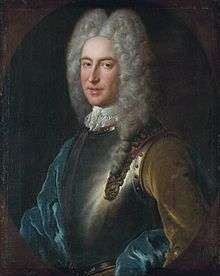
Its four main ideological tenets drew on a theology shared by Nonjurors, Anglicans and Scots Episcopalians.[87] They were, firstly, the divine right of kings, their accountability to God, not man or Parliament; secondly that monarchy was a divine institution; thirdly, the crown's descent by indefeasible hereditary right, which could not be overturned or annulled; and lastly the scriptural injunction of passive obedience and non-resistance, even towards monarchs of which the subject might disapprove.[88][89] Jacobites attempted, however, to draw a distinction between 'absolute' and 'arbitrary' power.[90] The exact interpretation of the monarch and subject's rights and duties varied between different writers, with Nonjuror Charles Leslie being perhaps the most extreme divine right theorist, although even he argued the monarch was bound by "his oath to God, as well as his promise to his people" and "the laws of justice and honour".[90]
Jacobite political discourse argued that divinely sanctioned authority was the main moral safeguard of society, while its absence led to party strife.[91] It maintained that the 1688 Revolution had allowed self-interested minorities - Whigs, religious dissenters, and foreigners - to take control of the state and oppress the weak.[92] However, such sentiments were not always consistently held within the Jacobite community, or restricted to Jacobites alone:[93] many Whigs, and Church of England clergy, also argued that the post 1688 succession was "divinely ordained".[94][89]
As time progressed, Jacobite discourse grew closer to mainstream Toryism; post 1710 pamphleteers began to blame the exile of the Stuarts on a "malevolent" Whig faction, rather than the nation collectively.[95] After the Act of Settlement, Jacobite propagandists deemphasised the purely legitimist elements in their writing and by 1745, active promotion of hereditary and indefeasible right was restricted largely to a few Scots Jacobites, notably the Episcopalian Lords Pitsligo and Balmerino.[96] They instead began to focus on populist themes such as opposition to a standing army, electoral corruption and social injustice.[71] By the 1750s Charles himself promised triannual parliaments, disbanding the army and legal guarantees on press freedom.[97] Such tactics broadened their appeal but also carried risks, since they could always be undercut by a government prepared to offer similar concessions.[98] Tensions between doctrinaire Jacobites and their broader-based supporters surfaced in the 1745 rebellion, when many of the Scots had a primary goal of dissolving the 1707 Union: after Prestonpans, they preferred to negotiate rather than invade England as Charles wanted.[99]
More generally, Jacobite theorists reflected broader currents in Enlightenment thought, appealing to those attracted to a monarchist solution to perceived modern decadence.[100] Populist songs and tracts presented the Stuart monarch as a king capable of putting right a wide range of ills and restoring social harmony; a man who continued to eat English beef and consume English beer in exile.[101] While particularly calculated to appeal to Tories, the wide range of themes adopted by Jacobite pamphleteers and agents periodically drew in disaffected Whigs and former radicals: such "Whig-Jacobites" were highly valued by James II's exiled court, but seem to have mainly viewed him a potentially weak king from whom it would be easy to extract concessions in the event of a restoration.[102]
Community
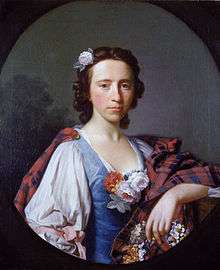
While Jacobite agents continued in their attempts to recruit the disaffected, the most committed Jacobites were often linked by relatively small family networks, particularly in Scotland; Jacobite activities in areas like Perthshire and Aberdeenshire centred on a limited number of influential families heavily involved in 1715 and 1745.[103]
Some of the most powerful landowning families preserved their establishment loyalties, but maintained traditions of Stuart allegiance by 'permitting' younger sons to become involved in active Jacobitism; in 1745, Lewis Gordon was widely believed to be a proxy for his brother, the Duke of Gordon.[104] Many Jacobite leaders were closely linked to each other and the exile community by marriage or blood. This has led some historians, notably Bruce Lenman, to characterise the Jacobite risings as French-backed coup attempts by a small network drawn from the elite, though this view is not universally accepted.[105]
Family traditions of Jacobite sympathy were reinforced through objects such as inscribed glassware or rings with hidden symbols, although many of those that survive are in fact 19th century neo-Jacobite creations. Other family heirlooms contained reference to executed Jacobite "martyrs", for which the movement preserved an unusual level of veneration.[106] Tartan cloth, widely adopted by the Jacobite army in 1745, was used in portraiture as a symbol of Stuart sympathies, even before the Rising. Outside elite social circles, the Jacobite community circulated propaganda and symbolic objects through a network of clubs, print-sellers and pedlars, aimed at the provincial gentry and "middling sort".[107] In 1745, Prince Charles ordered commemorative medals and miniature pictures for clandestine distribution.[107]
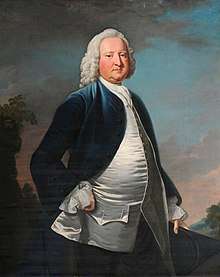
Among the more visible elements of the Jacobite community were drinking clubs established in the early 18th century, such as the Scottish Bucks Club or the "Cycle of the White Rose", led by Welsh Tory Sir Watkin Williams-Wynn.[108] Others included the "Sea Serjeants", largely composed of South Wales gentry or the "Independent Electors of Westminster" led by the Glamorganshire lawyer David Morgan, executed for his role in 1745.[109] Other than Morgan, the vast majority of their members took no part in the 1745 Rising; Charles later suggested he "will do for the Welsh Jacobites what they did for me. I will drink their health".[110]
Jacobites relied heavily on symbols, which were impossible to prosecute, the most common being the White rose of York, adopted after 1688 for reasons now unclear. Various origins have been suggested, including its use as an ancient Scottish royal device, its association with James II as Duke of York, or Charles I being styled as the "White King".[111] Jacobite military units often used plain white standards and white cockades: green ribbons were another recognised Stuart symbol despite also having Whig associations.[112] Many of these symbols were also employed by Tories to provoke government supporters, such as the oak boughs or oak leaf associated with Charles II.[113] Restoration Day, on May 29, was an occasion for displays of Stuart sympathy, as was James Stuart's birthday on 10 June, or "White Rose Day".[114]
Decline
.jpg)
Despite being greeted as a hero on his return to Paris, Charles' reception behind the scenes was more muted. D’Éguilles, unofficial French envoy to the Jacobites, had a low opinion of him and other senior Jacobites, describing Lochgarry as "a bandit", and suggesting George Murray was a British spy. For their part, the Scots were disillusioned by lack of meaningful English or French support, despite constant assurances of both.[115]
As early as 1745, the French were struggling with the costs of the War of the Austrian Succession, and in June 1746, they began peace negotiations with Britain at Breda. Victories in Flanders in 1747 and 1748 actually worsened their position by drawing in the previously neutral Dutch Republic, whose shipping they relied on to avoid the British naval blockade.[116] By 1748, food shortages among the French population meant ending the war was a matter of urgency, but the British refused to sign the Treaty of Aix-la-Chapelle while Charles remained in France. After he ignored requests to leave, the French lost patience; in December 1748, he was seized on his way to the Opéra and briefly jailed before being expelled.
The rising also highlighted the reality that a low level, ongoing insurgency was far more cost-effective for the French than a restoration.[lower-alpha 1] As the Stuarts themselves recognised, this form of warfare was devastating for the local populace; it took fifty years for the area around Drogheda to recover from the destruction inflicted by Jacobite troops prior to withdrawal in 1690.[117] By exposing these divisions, the 1745 Rising largely ended Jacobitism as a viable political alternative.[118]
The British authorities enacted a series of measures designed to prevent the Scottish Highlands being used for another rising. New forts were built, the military road network finally completed and William Roy made the first comprehensive survey of the Highlands.[119] Even before 1745, the clan system had been under severe stress due to changing economic conditions; the Heritable Jurisdictions Act removed feudal controls by Highland chiefs, while the Act of Proscription outlawed Highland dress unless worn in military service.[120]
Elibank plot
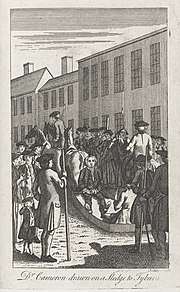
From 1749 to 1751 Charles began exploring a further rising in England; he considered converting to Anglicanism, a proposal that had outraged his father James when previously suggested.[121] In 1750 he secretly visited London: the English Jacobites were clear that they would do nothing without foreign backing, which despite Charles's overtures to Frederick II of Prussia seemed unlikely.
A plot to capture or assassinate George II, headed by Alexander Murray of Elibank, eventually stalled but not before Charles had sent two exiled Scots as agents. One was Archibald Cameron, responsible for recruiting the Cameron regiment in 1745: he was allegedly betrayed by his own clansmen on returning to Scotland and executed on 7 June 1753.[122] In a 1754 dispute with the English conspirators, a drunken and increasingly desperate Charles threatened to publish their names for having "betrayed" him; most remaining English sympathisers now left the cause.[123]
Loss of French support
In 1759 French naval defeats at Lagos and Quiberon Bay forced them to abandon a planned invasion of Britain, which would have placed Charles on the throne. It is often considered the last realistic chance for the Jacobites. With its passing, Charles lapsed further into alcoholism and was soon entirely abandoned by the French government, who saw little further use for him. The English Jacobites stopped sending funds, and by 1760 Charles, who had returned to Catholicism, was relying on the Papacy to support his lifestyle in Rome.
When James Edward Stuart died in 1766, the Holy See refused to recognise Charles as the lawful sovereign of Great Britain. In 1788, Scottish Catholics swore allegiance to the House of Hanover, and resolved two years later to pray for King George by name.
Henry IX
When Charles died in 1788 the Stuart claim to the throne passed to his younger brother Henry, who had become a Cardinal, and who now styled himself King Henry IX of England. After falling into financial difficulty during the French Revolution, he was granted a stipend by George III. However, he never actually surrendered his claims to the throne, though all former supporters of Jacobitism had stopped funding. Following the death of Henry in 1807, the Jacobite claims passed to those excluded by the Act of Settlement: initially to the House of Savoy (1807–1840), then to the Modenese branch of the House of Habsburg-Lorraine (1840–1919), and finally to the House of Wittelsbach (1919–present). Franz, Duke of Bavaria is the current Jacobite heir. Neither he nor any of his predecessors since 1807 have pursued their claim. Henry, Charles and James are memorialised in the Monument to the Royal Stuarts in the Vatican.
Analysis
Traditional Whig historiography viewed Jacobitism as marginal to the progression towards present-day Parliamentary democracy, taking the view that as it was defeated, it could never have won.[124] Representing "pre-industrial paternalism" and "mystical loyalism" against forward-thinking individualism, this conception of Jacobitism was reinforced by Macaulay's stereotype of the typical "Tory-Jacobite squire" as a "bigoted, ignorant, drunken philistine".[124]
More recent analyses, such as that of J. C. D. Clark, suggest that Jacobitism can instead be regarded as part of a "deep vein of social and political conservatism running throughout British history", arguing that the Whig settlement was not as stable as has been depicted.[125] Further interest in Jacobite studies has been prompted by a reassessment of the nationalist aspirations of Scots Jacobites in particular, emphasising its place as part of an ongoing political idea.
Romantic revival
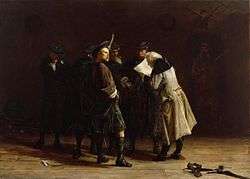
As the political danger represented by Jacobitism receded, a nostalgic and sentimental view of the movement appeared, particularly with respect to the final 1745 rebellion. Relics and mementoes of 1745 were preserved and Charles himself became celebrated in "increasingly emotional and sentimental language".[126] The publication in the 1830s of parts of The Lyon in Mourning by Episcopalian bishop Robert Forbes (1708-1775), a collection of source material and interviews with Jacobite participants in the 1745 rising, reinforced this memorialising tendency.[126]
19th century historiography often presented the Scots Jacobites as driven by a romantic attachment to the House of Stuart, rather than as having a wide range of individual motivations. This suited a Victorian depiction of Highlanders as a "martial race", distinguished by a tradition of a "misplaced loyalism" since transferred to the British crown.[127] The participation of Lowland and north-eastern gentry in the movement was less emphasised, while the Irish Jacobites were presented as a largely negative influence on Charles in 1745.
Walter Scott, author of Waverley, a story of the 1745 rebellion, combined romantic, nostalgic Jacobitism with an appreciation of the practical benefits of Union. In 1822 he arranged a pageantry of reinvented Scottish traditions for the visit of King George IV to Scotland when George IV visited Edinburgh as a successor to his distant relative Charles Stuart. The tartan pageantry was immensely popular, and Highland clothing, previously associated with rebellion and disorder became Scotland's National Dress. 1824 saw the restoration of some Jacobite titles and 1829 Catholic emancipation; with political Jacobitism now safely confined to an "earlier era", the hitherto largely ignored site of the final Jacobite defeat at Culloden began to be celebrated.[128]
Many Jacobite folk songs emerged in Scotland in this period; a number of examples were collected by Scott's colleague James Hogg in his Jacobite Reliques, including several he likely composed himself. Nineteenth century Scots poets such as Alicia Spottiswoode and Carolina Nairne, Lady Nairne (whose "Bonnie Charlie" remains popular) added further examples. Relatively few of the surviving songs, however, actually date from the time of the risings; one of the best known is the Irish song Mo Ghile Mear, which although a more recent composition is based on the contemporary lyric Buan ar Buairt Gach Ló by Seán Clárach Mac Domhnaill.
Neo-Jacobite revival
There was a brief revival of political Jacobitism in the late 1880s and into the 1890s.[129] A number of Jacobite clubs and societies were formed, starting with the Order of the White Rose founded by Bertram Ashburnham in 1886. In 1890, Herbert Vivian and Ruaraidh Erskine co-founded a weekly newspaper, The Whirlwind, that espoused a Jacobite political view.[130] Vivian, Erskine and Melville Henry Massue formed the Legitimist Jacobite League of Great Britain and Ireland in 1891, which lasted for several years. Vivian went on to stand for Parliament four times on a Jacobite platform – though he failed to be elected each time.[131] The revival largely came to an end with the First World War and the various societies of the time are now represented by the Royal Stuart Society.
In literature and popular culture
Jacobitism has been a popular subject for historical novels, and for speculative and humorous fiction.
- The historical novels Waverley (1814) and Rob Roy (1817) by Sir Walter Scott focus on the first and second Jacobite rebellions.
- Kidnapped (1886) is a historical fiction adventure novel by the Scottish author Robert Louis Stevenson that features the intrigues of Jacobite troubles in Scotland.
- In the 1920s, D. K. Broster wrote the Jacobite Trilogy of novels featuring the dashing hero Ewen Cameron.
- Joan Aiken's Wolves Chronicles have as background an alternative history of England, in which King James III, a Stuart, is on the throne, and the Hanoverians plot to overthrow him.
- A fictional account is given of the Jacobite/Hanoverian conflict in The Long Shadow, The Chevalier and The Maiden, Volumes 6–8 of The Morland Dynasty, a series of historical novels by author Cynthia Harrod-Eagles. Insight is given through the eyes of the Morland family into the religious, political and emotional issues at the heart of the struggle.
- Corrag (also known as Witch Light) (2009) by Susan Fletcher centres on the Massacre of Glencoe. It offers the eyewitness account of Corrag, a reputed witch.
- The historical book series Outlander
Claimants to the thrones of England, Scotland, Ireland and France
- James II and VII (6 February 1685 – 16 September 1701).
- James III and VIII (16 September 1701 – 1 January 1766), James Francis Edward Stuart, also known as the Chevalier de St. George, the King over the Water, or the Old Pretender. (Son of James II)
- Charles III (31 December 1720 – 31 January 1788), Charles Edward Stuart, also known as Bonnie Prince Charlie, the Young Chevalier, or the Young Pretender. (Son of James III)
- Henry IX and I (6 March 1725 – 13 July 1807), Henry Benedict Stuart, also known as the Cardinal King. (Son of James III)
Since Henry's death, none of the Jacobite heirs have claimed the English or Scottish thrones. Franz, Duke of Bavaria (born 1933), a direct descendant of Charles I, is the current legitimate heir of the house of Stuart. It has been suggested that a repeal of the Act of Settlement 1701 could allow him to claim the throne, although he has expressed no interest in doing so.[132]
Footnotes
- Summarised in a British intelligence report of 1755; "...'tis not in the interest of France the House of Stuart shoud ever be restored, as it would only unite the three Kingdoms against Them; England would have no exterior [threat] to mind, and [...] prevent any of its Descendants (the Stuarts) attempting anything against the Libertys or Religion of the People.
References
- Harris 2007, pp. 271–272.
- Barnes 1973, pp. 310-312.
- Gooch 2001, p. ?.
- Stephen 2010, p. 49.
- Ryan 1975, pp. 122-124.
- Jacob 1976, pp. 335-341.
- Kenyon, Ohlmeyer 1998, p. 12.
- Kenyon, Ohlmeyer 1998, p. 16.
- Lenihan 2001, pp. 20-23.
- Kenyon, Ohlmeyer 1998, p. 31.
- Manganiello 2004, p. 10.
- Lenihan 2001, pp. 11-14.
- Lenihan 2016, pp. 140-142.
- Worden 2010, pp. 63-68.
- Harris 1993, pp. 581-590.
- Miller 1978, pp. 124-125.
- McGrath 1996, pp. 27-28.
- Harris 1993, pp. 123–127.
- Spielvogel 2014, p. 410.
- Harris 2007, pp. 235–236.
- Harris 2007, pp. 3-5.
- Coward, p. 460.
- McKay 1983, pp. 138–140.
- Lenihan 2016, pp. 174-179.
- Lynn 1999, p. 215.
- Somerset 2012, pp. 532-535.
- Lenman 1982, p. 36.
- McLynn 1982, pp. 98-99.
- Ó Ciardha 2000, pp. 21,30.
- Connolly 2014, pp. 27-42.
- Morely 2016, p. 333.
- Connolly 1992, pp. 233-249.
- Ó Ciardha 2000, pp. 77-79.
- Lenihan 2008, p. 175.
- Ó Ciardha 2000, p. 89.
- Doyle 1997, pp. 29–30.
- Gillen 2016, p. 52.
- Lenihan, Consolidating Conquest, p.178
- Lenihan, Consolidating Conquest, p.178
- Padraig Lenihan, The Last Cavalier, Richard Talbot (1631-91), p.136
- Lenihan, The Last Cavalier, p.136
- Lenihan 2016, p. 177.
- Moody, Martin and Byrne 2009, p. 490.
- Lenihan 2008, p. 183.
- Ó Ciardha 2000, p. 84.
- Ó Ciardha 2000, p. 85.
- Lenihan 2016, p. 199.
- About 130 cavalry and 750 infantry in 1745 Scots Wars Irish Contingents in 1745-46
- Morley 2007, p. 194.
- Lenihan 2016, p. 244.
- Garnham 2002, pp. 81-82.
- Ó Ciardha 2000, p. 144.
- Gillen 2016, p. 59.
- Ó Ciardha 2000, p. 374.
- Connolly 2003, pp. 64-65.
- Graham 2002, p. 51.
- Morley 2007, pp. 198-201.
- Szechi 1994, p. 64.
- Brown 2002, p. 62.
- McLynn 1985, p. 81.
- McLynn 1982, p. 98.
- Colley, p. 26.
- McLynn 1982, p. 107.
- Rogers 1982, pp. 70-88.
- Oates 2006, pp. 97-98.
- Yates 2014, pp. 37-38.
- Monod, p. 134.
- Szechi 1994, pp. 18-19.
- Overton 1902, pp. 467-496.
- Szechi 1994, p. 19.
- Colley 1985, p. 28.
- Szechi 1994, p. 77.
- McCann 1963, p. 20.
- Pittock 2016, p. 135.
- Hamilton 1963, p. 4.
- Szechi 1994, p. 67.
- Pittock 1998, p. 99.
- Macinnes 2007, p. 235.
- Strong 2002, p. 15.
- Szechi 1994, pp. 19-20.
- Shaw 1999, p. 89.
- Szechi 1994, p. 72.
- Pittock 2016, p. 26.
- Riding 2016, p. 337.
- McLynn 1982, pp. 109–110.
- McLynn 1982, p. 99.
- Szechi 1994, p. 92.
- Clark 1985, p. 89.
- Brown 2002, p. 47.
- Monod, p. 18.
- Monod, p. 22.
- Monod 1993, p. 92.
- Erskine-Hill 1982, p. 55.
- Gibson 2012, p. 12.
- Monod, p. 28.
- McLynn 1982, p. 109.
- Szechi 1994, p. 38.
- Colley 1985, p. 29.
- Riding 2016, p. 199.
- Monod, p. 81.
- Szechi 1992, p. 36.
- Szechi 1994, p. 60.
- Szechi, Sankey 2001, pp. 95–96.
- Lenman 1980, p. 255.
- Lenman 1980, p. 256.
- Szechi 1992, pp. 36-7.
- Monod, pp. 81-82.
- Lord 2004, p. 40.
- Riding 2016, p. 378.
- Pittock 1997, p. 107.
- Pittock 1998, p. 73.
- Rogers & 25.
- Pittock 1998, pp. 72-3.
- Monod, p. 210.
- McLynn 1985, pp. 177–181.
- Black 1999, pp. 97-100.
- O'Sullivan 1992, p. 435.
- Colley, p. 28.
- Seymour 1980, pp. 4–9.
- Campsie 2017.
- Corp 2011, p. 334.
- Lenman 1980, p. 27.
- Monod, p. 345.
- Szechi 1994, p. 5.
- Szechi 1994, p. 6.
- Pittock 2016, p. 137.
- Pittock 2016, p. 143.
- Pittock 2016, p. 146.
- Pittock, Murray (1 August 2014). Spectrum of Decadence: The Literature of the 1890s. Routledge.
- "The Whirlwind". New York: The Metropolitan Museum of Art.
- "Stirling Burghs Vacancy". Dundee Evening Telegraph. 29 April 1908.
- Richard Alleyne and Harry de Quetteville (7 April 2008). "Act repeal could make Franz Herzog von Bayern new King of England and Scotland". Daily Telegraph. Retrieved 19 May 2011.
Sources
- Barnes, Robert P (1973). "James VII's Forfeiture of the Scottish Throne". Albion: A Quarterly Journal Concerned with British Studies. 5 (4). doi:10.2307/4048254. JSTOR 4048254.
- Black, Jeremy (1999). From Louis XIV to Napoleon: The Fate of a Great Power. Routledge. ISBN 978-1-857-28934-3.
- Brown, Richard (2002). Church and State in Modern Britain 1700-1850. Routledge.
- Chambers, Liam (author), Binasco, Matteo (ed) (2018). Rome and The Irish Mission at home in Irish Catholicism in the Atlantic World, 1622-1908. Palgrave Press. ISBN 978-3319959740.CS1 maint: extra text: authors list (link)
- Charteris, Evan (1907). A Short Account of the Affairs of Scotland. David Douglas, Edinburgh.
- Colley, Linda (1985). In Defiance of Oligarchy: The Tory Party 1714-60. Cambridge UP.
- Connolly, Sean (1992). Religion, Law and Power: Making of Protestant Ireland, 1660-1760. Clarendon Press. ISBN 978-0198201182.
- Connolly, Sean (2014). Patriotism and Nationalism in The Oxford Handbook of Modern Irish History. OUP. ISBN 978-0199549344.
- Connolly, Sean (2003). "Jacobites, Whiteboys and Republicans: Varieties of Disaffection in Eighteenth-Century Ireland". Eighteenth-Century Ireland / Iris an Dá Chultúr. 18. JSTOR 30070994.
- Corp, Edward (2011). The Stuarts in Italy, 1719-1766. Cambridge UP.
- Coward, Barry (1980). The Stuart Age 1603–1714. Longman. ISBN 978-0582488335.
- Cruikshanks, Lauchlin Alexander (2008). The Act of Union: Death or Reprieve for the Highlands?. Wesleyan University. OCLC 705142720.
- Doyle, Thomas (1997). "Jacobitism, Catholicism and the Irish Protestant Elite, 1700–1710". Eighteenth-Century Ireland / Iris an Dá Chultúr. 12: 28–59. JSTOR 30071383.
- Garnham, Neal (author), Clark, Peter (ed) (2002). Police & Public Order in 18th Century Dublin in Two Capitals: London and Dublin, 1500-1840. British Academy. ISBN 978-0197262474.CS1 maint: extra text: authors list (link)
- Gibson, William (2012). The Church of England 1688-1832: Unity and Accord. Routledge.
- Gillen, Ultan (2016). Ascendency Ireland, 1660-1800 in Princeton History of Modern Ireland. Princeton University Press. ISBN 978-0691154060.
- Graham, Brian (ed.) (2002). In Search of Ireland: A Cultural Geography. Taylor and Francis. ISBN 9781134749188.CS1 maint: extra text: authors list (link)
- Hamilton, Henry (1963). An economic history of Scotland in the Eighteenth century. Clarendon Press.
- Harris, Tim (1993). Politics under the Later Stuarts: Party Conflict in a Divided Society, 1660–1715. Longman. ISBN 978-0582040823.
- Harris, Tim (2007). Revolution; the Great Crisis of the British Monarchy 1685–1720. Penguin. ISBN 978-0141016528.
- Harris, Tim (1993). "Party Turns? Or, Whigs and Tories Get Off Scott Free". Albion: A Quarterly Journal Concerned with British Studies. 25 (4). JSTOR 4051311.
- Hayes, Richard (1949). "Ireland and Jacobitism". Studies: An Irish Quarterly Review. 38 (149).
- Jacob, Margaret C (1976). "Millenarianism and Science in the Late Seventeenth Century". Journal of the History of Ideas. 7 (32). JSTOR 2708829.
- James, Francis Godwin (1979). "The Church of Ireland in the Early 18th Century". Historical Magazine of the Protestant Episcopal Church. 48 (4). JSTOR 42973720.
- Kenyon, John (ed), Ohlmeyer, Jane (1998). The Civil Wars: A Military History of England, Scotland and Ireland, 1638-60. Oxford University Press. ISBN 978-0198662228.CS1 maint: extra text: authors list (link)
- Lenihan, Padraig (2008). Consolidating Conquest: Ireland 1603-1727 (2016 ed.). Routledge. ISBN 978-1138140639.
- Lenihan, Padraig (2001). Confederate Catholics at War 1641-1649. Cork University Press. ISBN 978-1859182444.
- Lenihan, Padraig (2001). Introduction; Conquest and Resistance: War in Seventeenth-Century Ireland. Brill. ISBN 978-9004117433.
- Lenman, Bruce (1980). The Jacobite Risings in Britain 1689–1746. Methuen Publishing. ISBN 978-0413396501.
- Lord, Evelyn (2004). The Stuart Secret Army: The Hidden History of the English Jacobites. Pearson. ISBN 978-0582772564.
- Macinnes, Allan (2007). "Jacobitism in Scotland: Episodic Cause or National Movement?". Scottish Historical Review. 86 (222).
- Manganiello, Stephen (2004). The Concise Encyclopedia of the Revolutions and Wars of England, Scotland, and Ireland, 1639-1660. Scarecrow Press.
- McCann, Jean E (1963). The Organisation of the Jacobite Army. PHD thesis Edinburgh University. hdl:1842/9381. OCLC 646764870.
- McCormick, Ted (2014). Restoration Ireland, 1660–1688; in The Oxford Handbook of Modern Irish History. OUP. ISBN 978-0198768210.
- McGrath, Charles Ivar (1996). "Securing the Protestant Interest: The Origins and Purpose of the Penal Laws of 1695". Irish Historical Studies. 30 (117): 25–46. doi:10.1017/S0021121400012566. hdl:10197/9696. JSTOR 30008727.
- McKay, Derek (1983). The Rise of the Great Powers 1648–1815. Routledge. ISBN 978-0582485549.
- McLynn, Frank (1982). "Issues and Motives in the Jacobite Rising of 1745". The Eighteenth Century. 23 (2): 97–133. JSTOR 41467263.
- McLynn, Frank (1985). The Jacobites. Routledge.
- Miller, John (1978). James II; A study in kingship. Menthuen. ISBN 978-0413652904.
- Mitchell, Albert (1937). "The Non-Jurors; 1688-1805". The Churchman. 51 (2).
- Monod, Paul (1993). Jacobitism and the English People, 1688-1788. Cambridge UP. ISBN 9780521447935.
- Moody; Martin; Byrne (eds.) (2009). A New History of Ireland: Volume III: Early Modern Ireland 1534-1691. OUP. ISBN 9780198202424.CS1 maint: extra text: authors list (link)
- Morley, Vincent (2007). "The Continuity of Disaffection in Eighteenth-Century Ireland". Eighteenth-Century Ireland / Iris an Dá Chultúr. 22.
- Morely, Vincent (2016). The Irish Language in Princeton History of Modern Ireland. Princeton University Press. ISBN 978-0691154060.
- Ó Ciardha, Eamonn (2000). Ireland and the Jacobite Cause, 1685-1766: A Fatal Attachment. Four Courts Press. ISBN 978-1851825349.
- Oates, Jonathan (2016). The Last Battle on English Soil, Preston 1715. Routledge.
- Overton, JH (2018). The Nonjurors: Their Lives, Principles, and Writings (2018 ed.). Wentworth Press. ISBN 978-0530237336.
- Parrish, David (2017). Jacobitism and Anti-Jacobitism in the British Atlantic World, 1688–1727. Royal Historical Society. ISBN 978-0861933419.
- Parker, Geoffrey (2002). Empire, War and Faith in Early Modern Europe (2003 ed.). Penguin. ISBN 978-0140297898.
- Pittock, Murray (1998). Jacobitism. Palgrave Macmillan. ISBN 978-0333667989.
- Pittock, Murray (1997). Inventing and Resisting Britain. Palgrave Macmillan.
- Pittock, Murray (1995). The Myths of the Jacobite Clans. Edinburgh University Press.
- Plank, Geoffrey (2005). Rebellion and Savagery: The Jacobite Rising of 1745 and the British Empire. University of Pennsylvania Press. ISBN 978-0812238983.
- Riding, Jacqueline (2016). Jacobites: A New History of the 45 Rebellion. Bloomsbury. ISBN 978-1408819128.
- Rogers, Nicholas (1998). Crowds, Culture, and Politics in Georgian Britain. Oxford UP.
- Rogers, Nicholas (1982). Riot and Popular Jacobitism in Early Hanoverian England, in Ideology and conspiracy: aspects of Jacobitism, 1689-1759. John Donald Publishers Ltd. ISBN 978-0859760843.
- Ryan, Conor (1975). "Religion and State in Seventeenth-Century Ireland". Archivium Hibernicum. 33. doi:10.2307/25487416.
- Shaw, John S. (1999). The Political History of Eighteenth-Century Scotland. Macmillan.
- Smith, Hannah (2013). Georgian Monarchy: Politics and Culture, 1714–60. Cambridge University Press. ISBN 978-0521828765.
- Somerset, Anne (2012). Queen Anne; the Politics of Passion. HarperCollins. ISBN 978-0007203765.
- Spielvogel, Jackson J (1980). Western Civilization. Wadsworth Publishing. ISBN 1285436407.
- Stephen, Jeffrey (January 2010). "Scottish Nationalism and Stuart Unionism". Journal of British Studies. 49 (1, Scottish Special).
- Szechi, Daniel (1994). The Jacobites: Britain and Europe, 1688–1788 (First ed.). Manchester University Press. ISBN 978-0719037740.
- Szechi, Daniel; Sankey, Margaret (November 2001). "Elite Culture and the Decline of Scottish Jacobitism 1716–1745". Past & Present. 173 (173). doi:10.1093/past/173.1.90. JSTOR 3600841.
- Worden, Blair (2010). "Oliver Cromwell and the Protectorate". Transactions of the Royal Historical Society. 20 (6). JSTOR 41432386.
- Yates, Nigel (2014). Eighteenth Century Britain: Religion and Politics 1714-1815. Routledge.
External links
- BBC-Interactive Timeline of British History
- General History of the Highlands
- The University of Guelph Library, Archival and Special Collections, has more than 500 Jacobite pamphlets, histories, and literature in its rare books section introduced at https://web.archive.org/web/20100106050248/http://www.lib.uoguelph.ca/resources/archival_%26_special_collections/the_collections/digital_collections/scottish/Jacobite_site_0.htm
- Ascanius; or, the Young Adventurer
